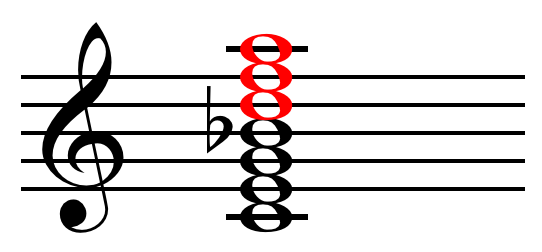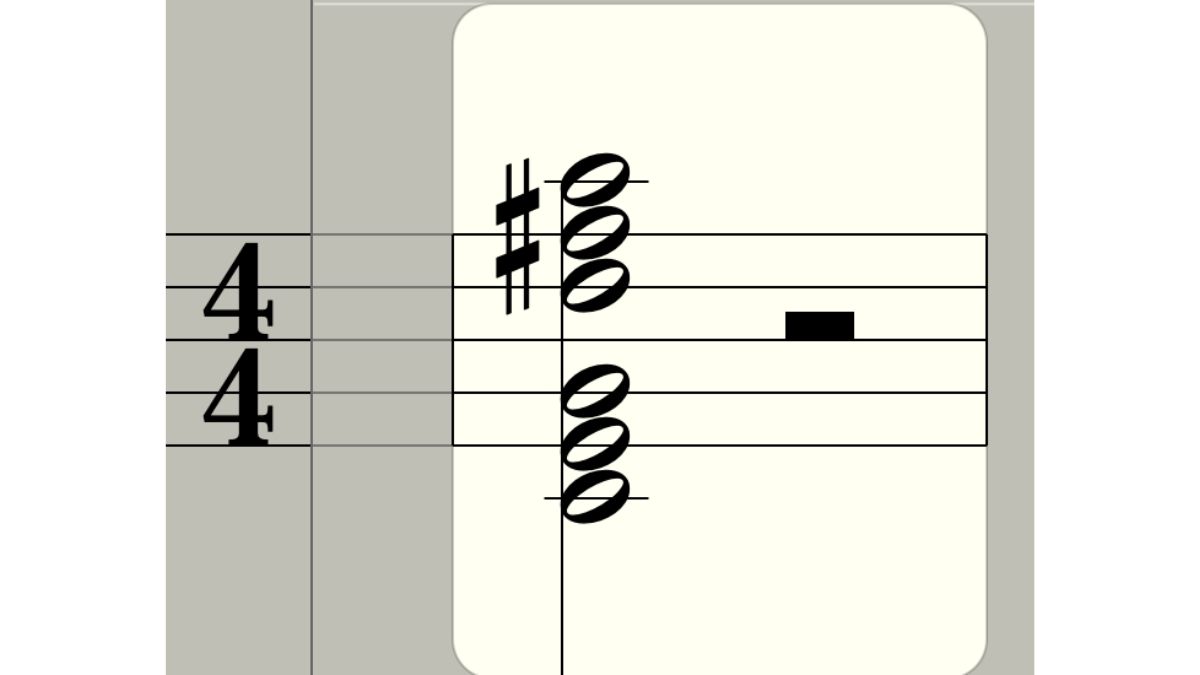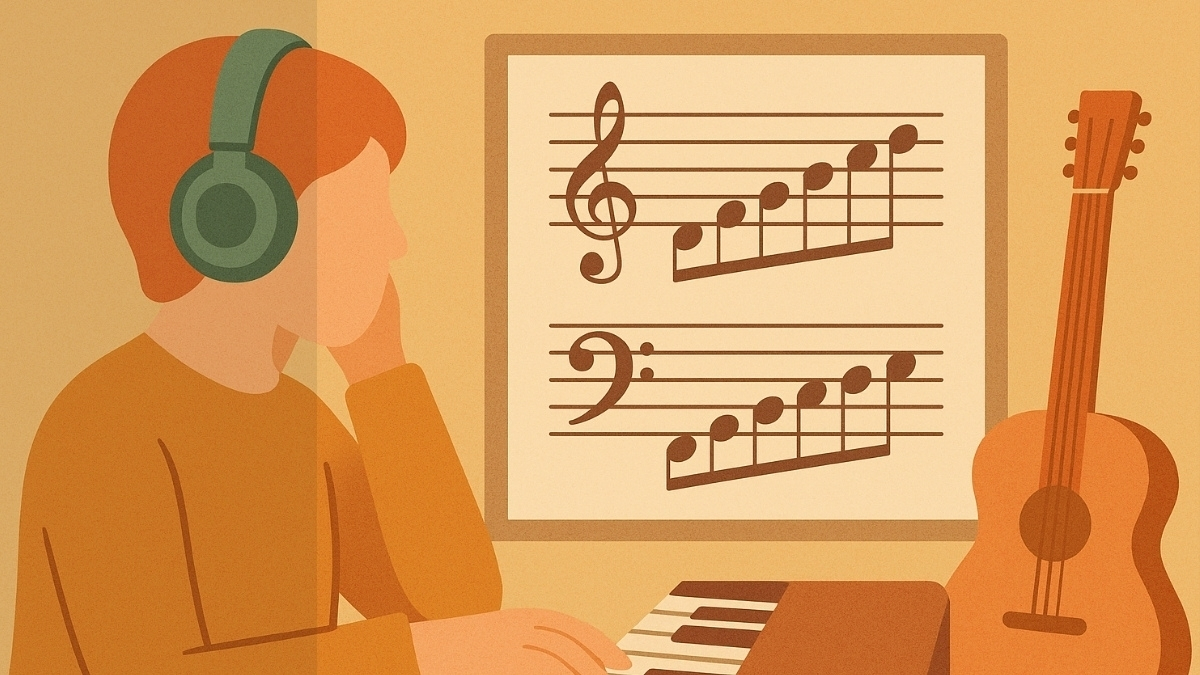What Is an Extended Chord? Expanding Beyond Basic Harmonics

Unlocking the power of harmony is one of the greatest creative leaps any musician can make. With limitless possibilities, harmony is the key to transforming simple melodies into something truly remarkable!
One way to do this is by incorporating “extended” chords into our songwriting and production. in this article, we will show you how to do it.
What are Extended Chords?
Simply put, extended chords are chords that use additional notes from the scale to achieve a richer sound. This is sometimes called adding “color” to chords.
Standard chords contain three notes, a root (1st), third (3rd) and fifth (5th), called a “triad”. These chords are formed by stacking thirds on top of one another.
This leaves four remaining notes in the scale that can theoretically be added in thirds to “extend” out the harmony of the chord further. These notes are the 2nd, 4th, 6th and 7th. In order to “extend” the chord, we move these notes up by one octave, to create a pattern that looks like this:
C D E F G A B C D E F G A B
1 2 3 4 5 6 7 8 9 10 11 12 13 14
Chord Tones
Extensions
One way to look at extensions is as stacked thirds. Instead of placing all of the notes inside of one octave, extensions must be spread out between two octaves.

Each extension will interact with the notes in the original triad in a different way, creating a distinct “tonality”.
C D E F G A B C D E F G A B
1 2 3 4 5 6 7 8 9 10 11 12 13 14
The 8th, 10th, 12th, and 14th are not considered extensions because they are the original chord tones placed one octave up.
How to Use Extended Chords?
Let’s use the standard I - V - vi - IV (1 5 6 4) chord progression commonly found in popular music as an example to begin our lesson…
In the key of “C”, the chords in this progression are:
C major - G major - A minor - F major
Common Types of Extended Chords
7th Chords
The extended series begins with the 7th. 7th chords build on basic triads by adding one additional note, the 7th, from the scale. In the key of “C” this would be the note B.
There are five types of 7th chords: major, dominant, minor, diminished, and augmented.
A “C” major 7th chord (CM7) is simply a C major triad with an added 7th, while a C minor 7th chord (Cm7) is a “C” minor triad with an added flatted 7th.
In this case, the 7th is lowered by one half-step, because we are using the notes from the C minor scale (C D Eb F G Ab Bb).
C major 7 = C E G B
C minor 7 = C Eb G Bb
As you can see, the 7th is a major or a minor 3rd above the previous note, the 5th, “G”. This follows the pattern of adding extensions ascending one 3rd at a time.
Here are the formulas for the other 7th chords:
Dominant: 1 3 5 b7
Half Diminished: 1 b3 b5 b7
Fully Diminished: 1 b3 b5 bb7
Augmented: 1 3 #5 7
You can use a 7th chord in place of just about any triad in a song. Referencing the I - V - vi - IV progression above, we could substitute 7th chords for each chord in the progression to give the progression a richer sound (use with caution, as this is very jazzy).
CM7 - G7 - Am7 - FM7
9th Chords
The next chord extension following the 7th is the 9th. The 9th is the 2nd scale degree played one octave above the tonic, again one third away from the previous extension, the 7th.
The 9th can be added to a major, minor or dominant 7th chord, and tends to lend itself to a richer, more dense sound.
Again referencing the I - V - vi - IV progression, we could substitute 9th chords as well:
CM79 - G79 - Am79 - FM79
In reality, we wouldn’t use a 9th chord for every chord in the progression, but using one of these would add some richness and color to the sound.
11th Chords
After the 9th, we proceed up by another third to the 11th.
When adding the extension of the 11th to a major 7th chord, something funny happens…
The 11th creates a minor 9th or b9 interval with the chord’s major 3rd. In the case of “C” major 7th, these would be the notes “E” and “F”, which are right next to one another on the piano.
Classical music theory avoids this relationship for its “unpleasant” sound. Instead, the 11th degree is raised by one half step, to a #11. This widens that minor 9th interval to a major 9th to avoid clashing.
The resulting chord: CM7#11 is commonly used in jazz music, and implies the lydian mode (major scale with a #4 i.e. #11th).
This is also true of a dominant 7th chord, which too contains a major 3rd. The resulting chord: C7#11 lends itself to jazz improvisation and is paired with the “lydian dominant” mode (a lydian scale with a b7).
When adding an 11th to a minor 7th chord, the natural 11th works just fine, because the minor chord’s existing minor 3rd prevents the added 11th from creating the rule-breaking b9.
You can try substituting these chords for any major/minor/dominant chord in a progression:
CM7#11 - G7#11 - Am7(11) - FM7#11
13th Chords
The final extension is the 13th. 13 chords typically sound slick and funky.
Adding a 13th to a minor 7th chord implies the funky/bluesy sounding “dorian” mode.
When added to a dominant 7th chord, the 13th creates a richer chord voicing.
CM7(13) - G7(13) - Am7(13) - FM7(13)
Just like the #11 we discussed, each chord extension can be raised or lowered by one half-step to create what is known as an “alteration”.
Don’t be scared if you see added accidentals next to a chord extension such as: b9, #11 or b13. These are simply extensions that are raised or lowered to create tension within the chord progression.
You’ll most likely see these alterations attached to “dominant” 7th chords. Dominant 7th chords typically resolve to a more stable chord, making them well-suited to carrying some exciting dissonant “tension” notes and providing a rewarding “resolution”.
Chords can take more than one extension at a time. Some complex chords even have three or all four extensions such as: E79(11) or Em79(11)(b13).
These chords are typically only used to denote very specific tonalities or modes for improvising.
Some musicians look at extensions as an “upper structure triad” or “UST”. This simply means that if we were to play the extensions together as a separate chord, they would form their own triad, built from the “upper” tones i.e. extensions.

In the key of “C” for example, the UST would be “D” major. By playing a “D” major chord on top of a “C” major chord, we would be playing the triad + all of the available chord extensions.
We’re thrilled to see how you take this exploration of more complex harmony and apply it to your own musical ventures!





Comments:
Jul 22, 2022
Jul 21, 2022
Jul 21, 2022
Login to comment on this post